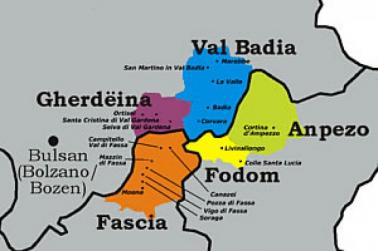The ladin language
The language of the five ladin valleys in the Dolomites

The "Ladin Dolomitan" language, in English Ladin of the Dolomites is made of several dialects, all part of the ladin linguistic group typical of the Dolomites, but also of the region Friuli and of the canton "Grigioni" in Switzerland. In Ladinia it's definitely the most spoken language, and together with other cultural characteristics (even if it is not the only one), is the common denominator between this region and the rest of the mountainous territory. The five valleys composing Ladinia are: Val Badia, where the "Badiot" is spoken, the Gardena valley with its "Gherdëina", the Fassa Valley (Fascian), Livinallongo (Fodom) and Ampezzo (Ampezan); with their around 30.000 inhabitants, they represent what is left of this territory, where ladin is spoken and also written, even if it was much more popular during the past.
The various dialects do not differ much the one from the other and are reciprocally influenced by neighbouring languages. For example the Gherdëina is influenced by German and the Ampezan and the Fodom by Venetian dialect.
The ladin language was born on our territory during the first century A.C.. This happened after the conquest of the Alpine region, Ladinia included, by the Romans under command of the roman chieftain Druso. Before the invasion, the inhabitants of the Dolomites were part of a very complex population, made of several different languages and cultures, among which there were Norics and Celts.
Very soon the Romans attributed to the Dolomites populations the collective name of "Rhaetia". A consistent part of the Rhaethians or Rhaethian-speaking population probably descends from the Etruscans, that were forced to pull back on the mountainous Alpine arc, specifically on the eastern-central Alps, following the cruel Celtic invasions in northern Italy; while on the other side, the Norics, descending from the Noric region (now central Austria) also fled because of the invasions by the Ruges, the Avars and the Slavics, this time. The Romans, represented by soldiers and employed, brought with them "vulgar" latin (everyday-spoken Ladin), that, combined with the Rhaetian and Noric languages of the Dolomites gave birth to Ladin. Afterwards, German and then Italian influenced ladin too, putting the basis of the language we nowadays know.
The ladin language is then composed of Rhaeto-Romanic idioms; in fact it is also called as Rhaeto-Roman language. It represents a language at all effects, independent from Italian dialects for structural and also historical reasons, and it is also known as such by many linguists, together with a European Union directive which confirmed that.
Ladin is very ancient language, that anticipates the birth of many Italian dialects and that resisted to the external pressures thanks to the natural morphology which hosted it. With the migration of German peoples, the ladin language was isolated in the secondary valleys that at the time were barely reachable. Nowadays, despite the pressures coming from the Italian language, on one hand, and German on the other, the ladin language remains alive in all the five valleys and represents for many a reason of big pride, contrasting the typical difficulties the minority groups have to face very often. The ladin language survived until nowadays, also thanks to the work of linguists and ladin people, who fought for the conservation of their mother tongue ("lingaz dla uma"), and not to forget the important factor of the isolation of the ladin valleys. Today ladin language and culture identify themselves also with their regional flag.
This was born on 5th May 1920 during a protest of the representatives of the ladin valleys on the Gardenia Pass. The protest concerned the decisions of the Saint-Germain Treaty, that did not recognize the existence of the ladin people, like the rest of the German populations in South Tyrol, that had recently been annexed to Italy. They claimed, of course, the rights to self-determination of the peoples, one of the fourteen points affirmed by Woodrow Wilson, together with the recognition as a separate distinct ethnic group. The ladin flag was born with horizontal stripes, starting from the top: light blue – white – green. The choice of colours fell again on these three, thinking to the Dolomites nature. Green as fields and woods, white like the snow that covers the Dolomites territory and blue like the sky that frames the massive mountain peaks of Ladinia. The flag was declared "national flag" of the ladin people and afterwards declared illegal by the fascist government. By the end of the war it showed up again on the Sella Pass together with three thousands ladins, who claimed their identity.
The ladin language has, in the last few years, taken many important steps forward. In Val Badia, Val Gardena and Fascia Valley schools are equal with both the Italian and German language and also provide the teaching of ladin, both spoken and written, together with English.
After many years the Church has taken a step in this direction as well, celebrating liturgies in ladin very often. In order to carry out a career in the public sector a language certificate, released by the Province, is necessary, to proof the knowledge of ladin, after taking a specific exam. All the official acts by public institutions, documents and toponymy are written in ladin as well. Ladinia is also provided with a newspaper "La Usc di Ladins" and with some tv and radio broadcasts in its language. Many are the publications in ladin, which, in the last few years, are supervised by the Union of Ladin people ("Uniun di Ladins"), present in each valley, together with the Institute Ladin Micurà de Rù. The latter plays a vital role in the conservation and the linguistic study of our mother tongue.


Comments:
You may also be interested for:
For your stay Ladinia recommends:
Ciasa Ploner
Frapes
Fordi
Haflingerhof